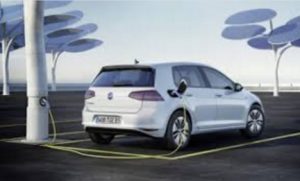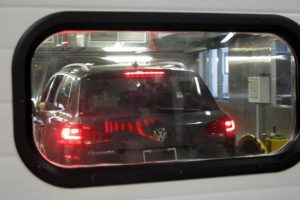by Jon LeSage, editor and publisher, Green Auto Market
Here’s my take on the 10 most significant and interesting occurrences during the past week…….
 VW EV 2025 target: As Volkswagen Group emerges from its diesel emissions scandal and faces increasingly strict government mandates on reducing vehicle carbon emissions, the German automaker expects electric vehicle sales to increase substantially by 2025. VW says it will have to sell about one million battery electric and plug-in hybrid vehicle per year by that year. VW projected that volume by analyzing regulatory environments in key markets, including draft legislation in China. That will require a huge leap from where VW stands right now in EV sales. Total cumulative volumes of all VW brand electrified cars (including VW, Audi, and Porsche) sold since the start is expected to be about 103,000 by the end of this year. For the first four months of 2016, the company sold just shy of 3,000 EV units in the U.S. with the Audi A3 Plug In, VW e-Golf, and Porsche Cayenne S E-Hybrid, according to HybridCar’s Dashboard.
VW EV 2025 target: As Volkswagen Group emerges from its diesel emissions scandal and faces increasingly strict government mandates on reducing vehicle carbon emissions, the German automaker expects electric vehicle sales to increase substantially by 2025. VW says it will have to sell about one million battery electric and plug-in hybrid vehicle per year by that year. VW projected that volume by analyzing regulatory environments in key markets, including draft legislation in China. That will require a huge leap from where VW stands right now in EV sales. Total cumulative volumes of all VW brand electrified cars (including VW, Audi, and Porsche) sold since the start is expected to be about 103,000 by the end of this year. For the first four months of 2016, the company sold just shy of 3,000 EV units in the U.S. with the Audi A3 Plug In, VW e-Golf, and Porsche Cayenne S E-Hybrid, according to HybridCar’s Dashboard.- Automakers going mobile: Mobility services continue to expand through investments by major automakers. Not long after Apple announced its $1 billion investment in Chinese ridesharing service Didi, Toyota, Volkswagen, and BMW made similar deals. Toyota is investing an undisclosed amount in Uber and is offering lease deals to Uber drivers. Volkswagen said on the same day it would invest $300 million in Gett, a smaller ride-hailing company. BMW is investing an undisclosed amount in a smartphone-powered carpooling service called Scoop. (Read more about it in the UberMan )
- Green bonds: Automakers are taking the green bond market very seriously with $2.5 billion raised in 2016 to finance electric and hybrid vehicles. In May, Toyota’s financial arm sold a $1.6 billion green bond to fund consumer purchases and leases of energy-efficient Toyota and Lexus vehicles; that was upsized from an earlier plan to sell $1.2 billion in green bonds. Chinese automaker Zhejiang Geely Holding Group raised $400 million this month in a green bond sale to finance development of zero-emission black cabs in the U.K. The bond was close to six times oversubscribed. Other automakers are likely to come to market with green bonds, said Stephen Liberatore, a portfolio manager at TIAA. Libatore’s TIAA-CREF Social Choice Bond Fund holds about $75 million of Toyota’s green bonds.
- Gigafactory tour: Tesla Motors will be opening the doors on its “Gigafactory” to the general public on July 29. The 130-acre battery-making plant isn’t due to start production on lithium ion cells until 2017. The date was revealed in email sent to customers, who won invitations to the customer-focused event by referring customers via Tesla’s referral program. Although only about 15% finished as of early May, the factory is already producing Tesla’s Powerpacks and Powerwalls.
- 2017 Fusion Energi mpg: Ford has been promoting its Fusion Energi as the plug-in hybrid with the longest range out there on battery and gasoline engine. The 2017 Fusion Energi does get a few improvements including getting 42 mpg over 38 the previous year; 97 MPGe over 88 last year; and 22 miles “Elec+Gas” range, over 20 miles for 2016. Its total driving range extended from 550 miles to 610.
- Hydrogen stations: Leading hydrogen station supplier FirstElement has 13 True Zero stations in operation now, mostly in the Los Angeles and San Francisco Bay areas. The company hopes to have the rest of the 19 done by early next year. That would give True Zero a dominant share of the market in California; there are just six other retail hydrogen stations not owned by the company.
- Lithium ion batteries: Popular Mechanics just published an educational article titled, “5 Things To Know About Making Electric Car Batteries Better.” Having tried out a radio-controlled Yeti Trophy Truck with a lithium battery, writer Ezra Dyer researched and answered a few questions. For one thing, the term lithium-polymer “is a reference to the packaging material, which is a polymer aluminum laminate. The inside is still lithium-ion, but the complete battery is dramatically different compared with a production electric car’s lithium-ion battery.” As far as all the advanced batteries being tested out in r&d centers, Dyer thinks that lithium-ion is the winner for now.
- Carsharing report: According to Navigant Research, global carsharing services revenue is expected to grow from $1.1 billion in 2015 to $6.5 billion in 2024. Growth in one-way carsharing services is prompting more companies to consider offering this service model. Utilization of the vehicles has improved as carsharing members can use one-way carsharing for shorter, spur of the moment trips. Adoption of plug-in electric vehicles (PEVs) in carsharing services is expected to increase as automakers promote this technology.
- Trump on biofuels and oil: Donald Trump has a plan for “complete American energy independence” in his campaign for president. In a recent speech, Trump said that he endorses repealing President Obama’s climate regulations, gaining independence from OPEC oil, and “canceling” the COP21 agreement. Trump would also like to “remove obstacles” to increased oil and gas development in the US. He does support the Renewable Fuel Standard (RFS) and ethanol production. Biofuel group Growth Energy says that both Trump and Hilary Clinton support the RFS.
- Start-stop: General Motors will be offering start-stop systems on at least one powertrain in every model it manufactures and sells by 2020. It comes from pressure to increase fuel efficiency in its fleets and because of advances in hardware. Starting with the 2017 model year, the U.S Environmental Protection Agency will award credits toward compliance with fuel economy standards to automakers who equip vehicles with start-stop systems.


 Volkswagen CEO Matthias Mueller will be speaking to the company’s senior management in mid-June on how VW will emerge from the diesel emissions scandal more as a
Volkswagen CEO Matthias Mueller will be speaking to the company’s senior management in mid-June on how VW will emerge from the diesel emissions scandal more as a 